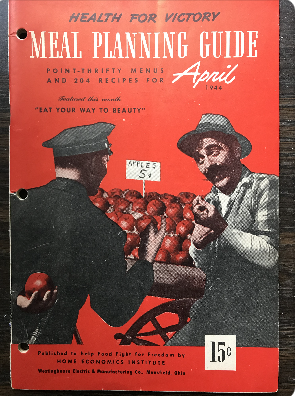Stewed Rhubarb (breakfast)
1 1/2 lbs rhubarb, chopped
1 1/2 cups water
1/2 cup sugar or honey (sweetening may vary with kind of rhubarb)
Place rhubarb and water in covered pan. Bring to a boil then turn to simmer for 10 minutes. Add sweetening, and continue simmering for 5 minutes.
English Monkey (lunch)
2 cups dried bread crumbs
2 cups milk
2 tablespoons butter or fortified margarine
1 cup soft mild cheese, cut into very small pieces
2 eggs, slightly beaten
1 teaspoon salt
Soak the bread crumbs in milk for 15 minutes. Melt butter or margarine in a saucepan. Add cheese and stir until cheese is melted. Add soaked bread crumbs, eggs and salt. Cook 3 minutes. Serve on toast or toasted crackers. Serves 6.
Carrot-Raisin Salad (lunch)
3 cups shredded carrots
1/4 teaspoon salt
1 cup seedless raisins
1/2 cup mayonnaise
Combine carrots, salt and raisins. Add mayonnaise and mix lightly. Serve on crisp lettuce. Serves 6.
Soya Bread (lunch)
2 cups soya flour
11 cups sifted all-purpose flour
4 cups milk
1 cup lukewarm water
5 tablespoons sugar
5 teaspoons salt
5 tablespoons shortening
2 cakes yeast
The soya flour in this recipe is not sifted before measuring. Stir flours together, and proceed as follows: Scald the milk and add it to the sugar and salt. Dissolve yeast with 1 cup water and add to it 1 teaspoon sugar. Let stand for 10 minutes. When the 4 cups of milk have cooled, add dissolved yeast to milk mixture. Next add flour and the softened shortening. Mix well and turn out onto a floured board. Knead until dough becomes elastic and does not stick to board. Place in a greased bowl, cover, allow to rise until double in bulk. Remove brad from bowl, punch down, and cut into nfour equal size loaves. Shape, cover and allow to stand 20 minutes on baking board.
Then flatten out each loaf and again reshape. Place in greased pans. Allow to rise until double in bulk, or until, when pressed with a finger, the imprint does not disappear. Bake in a preheated 350 F oven for 1 hour. This recipe makes four 1 1/2 lb loaves.
Note: To get a browned, softer top crust sprinkle top of unbaked loaves lightly with lukewarm water. To prevent a soggy bottom crust and to protect texture, remove bread from tins at once. Cool on wire cake coolers.
Bologna or Weiner Carrot Sandwich Filling (lunch box)
1/2 lb bologna or weiners
1/4 cup chopped pickles or relish
1/2 cup mayonnaise
1 1/2 teaspoons minced onion
Dash of Tabasco
2 Tablespoons pickle juice
1 cup ground carrots
1/2 cup chopped celery
Grind bologna or weiners and mix well with the other ingredients. Makes 2 2/3 cups, or 7 to 10 sandwiches.
Peanut Butter "Pep Up" Sandwich Filling (lunch box)
1/2 cup peanut butter
1/4 cup honey
1 cake compressed yeast.
Mix well.
Barbecued Cube Steak (dinner)
4 tablespoons catsup
3 tablespoons vinegar
1 1/2 tablespoons meat drippings, melted, but not hot
2 tablespoons water
2 teaspoons Worcestershire Sauce
1/2 teaspoon salt
4 cube steaks
(toasted buns with mustard butter is substituted in menu for the bread and shortening)
4 slices bread
3 tablespoons shortening
Combine catsup, vinegar, drippings, water, Worcestershire Sauce, and salt. Heat. Pour over steaks and allow to stand for 15 minutes. Drain, reserving sauce. Place steaks on broiler rack, 2 inches below broiler unit. Broil 5 minutes on each side, basting each side with sauce.
Spread bread with shortening and brown on broiler rack while meat broils. Place steaks on bread. Serves 4.
Parsley Potatoes (dinner)
New potatoes are best to serve this way. Either scrape or peel thin and boil. Just before removing from saucepan, pour melted butter or margarine over potatoes, and shake kettle vigorously to distribute butter/margarine. Chop parsley fine, and sprinkle over potatoes in serving bowl.
Pennsylvania Dutch Spinach (dinner)
2 slices bacon diced
3 cups chopped raw spinach
2 tablespoons all-purpose flour
1 cup hot water
1 tablespoon sugar
1 tablespoon vinegar
1 teaspoon salt
1/8 teaspoon pepper
2 hard-cooked eggs
Fry bacon until crisp; add bacon to spinach. Add flour to drippings and blend, add hot water and cook until thickened. Add sugar, vinegar, salt and pepper. Pour over spinach. Stir until well mixed. Garnish with sliced hand-cooked eggs.
Mustard Butter (for Toasted Buns -- dinner)
1/4 cup butter or fortified margarine
1 1/2 tablespoons prepared mustard
Cream butter/margarine and mustard together. Use as a spread for buns under the broiler or on meat sandwiches.
Broiled Grapefruit (dinner)
Prepare half a grapefruit in the usual manner [halve crosswise, use a knife to section and cut around edge between segments and white pith], removing the seeds. Sprinkle with 2 tablespoons brown sugar. Broil in oven until the sugar melts and the grapefruit is well browned.'
Applesauce (alternate breakfast)
10 medium size cooking apples
1/2 cup water
1/2 cup sugar
Wash, pare, remove core, and quarter apples. Add water. cover, and cook slowly until soft. Add sugar and simmer long enough to melt sugar. 7 servings.
Rarebit (alternate lunch)
1 tablespoon butter or fortified margarine
1/2 cup evaporated milk
few grains cayenne
1 egg
1/2 lb soft cheese, grated or cut in small pieces
salt and pepper to taste
Melt butter/margarine on high heat, add seasonings and cheese and turn to low heat. As cheese melts, add milk gradually, stirring constantly. Add slightly beaten egg. Two tablespoons of tomato soup, added just before serving, improves flavor and color. Serve on toast squares or crackers.
Cheese Fondue (alternate lunch)
3 eggs, separated
1 cup grated cheese
1 cup bread crumbs
1 cup milk
1 tablespoon butter or fortified margarine
1/2 teaspoon salt
Beat egg yolks until lemon colored. Cook cheese, bread crumbs, milk, butter/margarine and salt over low heat, stirring constantly until thick. Add beaten yolks. Beat egg whites until stiff, fold into cheese/milk/egg yolk mixture. Pour into a well greased, 2-quart casserole. Bake at 350 F for 30 minutes, or until a knife inserted comes out clean. Serve at once. Serves 6.
Pimento Sandwich Filling (alternate lunch)
1 tablespoon sugar
1 tablespoon butter or fortified margarine
1 tablespoon all-purpose flour
3 tablespoons vinegar
1 egg, well beaten
1/2 cup coffee cream or top milk
1/2 teaspoon salt
2 hard-cooked eggs, chopped
1 package cream cheese
1 tablespoon grated onion
3 tablespoons chopped pimento or diced green or red pepper
Cook sugar, butter/margarine, flour, vinegar, beaten egg, cream and salt on low heat until thick. Remove from heat and add chopped eggs, cream cheese, onion and pimento. Place in fruit jar and keep in refrigerator.
Dried Beef Gravy (alternate dinner)
1/2 lb dried beef
1 qt milk
4 tablespoons drippings
6 tablespoons all-purpose flour
Heat drippings in skillet. Brown the flour. Add shredded dried beef. Allow beef to brown and become well coated with flour. Use Medium heat. Add milk. Stir to prevent lumping.. Serve on brown rice, toast or crisp cereal.
Victory Hamburgers (alternate dinner)
1 lb ground beef
1/3 cup soya meal
1 teaspoon salt
1/8 teaspoon pepper
1/4 cup water
6 slices onion
2 tablespoons shortening
6 slices bacon
Add salt, pepper, and water to soya meal and mix thoroughly with the meat. Pat this mixture into n12 thin cakes. Spread onion slices, which have been browned in the shortening, on half of the meat cakes. Put the remaining cakes on top as a meat sandwich. Press edges together. Wrap each with a strip of bacon and fasten with a toothpick. Broil on each side for about 10 minutes or until brown.
Fried Ham and Eggs (alternate dinner)
1 1/2 slices ham, cut 1/2 inch thick
eggs
Slash edges of ham about 1/2 inch deep about 4 inches apart, to prevent curling. Grease hot pan lightly with ham fat. Brown ham on both sides, using a Medium heat. Remove from pan. Break eggs into hot fat. When eggs begin to set add 1 teaspoon water, cover tightly and cook until desired hardness. Place eggs on hot ham and serve immediately.
Stewed Tomatoes (alternate dinner)
1 can tomatoes
2 tablespoons butter or margarine
salt and pepper
1 teaspoon sugar
Place tomatoes in 2-qt covered saucepan. Turn heat to High to bring tomatoes to steaming point. Then simmer for 5 minutes. Add butter/margarine, salt, pepper and sugar.
Variation: Bread cubes or cracker crumbs can be added for thickening.
My thoughts:
I make stewed rhubarb and carrot-raisin salad all the time. Both are cheap and easy side dishes for my household. I don't measure with either of those, but add ingredients to taste.
The English Monkey sounds interesting. Maybe I will give that a try. The soft cheese could be cheddar. As I mentioned yesterday, this was a recipe popular during the Great Depression. It is sparing with eggs (for 6 people), but generous with cheese, and stretched with dried bread crumbs.
Soya bread must have been a recipe designed to contain more protein and other nutrients than standard wheat or white bread. That's quite a lot of milk in the recipe. But it would be a way to get additional calcium and protein into daily meals.
I'm not a fan of bologna or hot dogs straight from the package. Blending the ground meat with ground carrots does sound interesting, though. This might work with ground ham, for a ham spread. Has anybody here had deviled ham? My mother used to buy small cans of ground ham to make this. I imagine making the carrot bologna sandwich filling with ham might actually be good.
That's interesting that the recipe for "Pep Up" peanut butter spread would call for ordinary compressed yeast. I know brewer's yeast is used as a nutritional supplement to boost immunity and energy levels. It's high in B vitamins and many minerals. I would try the "Pep Up" sandwich filling made with brewer's yeast. I also think I would enjoy the pimento cheese spread. It looks fairly easy to make.
In the dinner menu I especially like the sound of the spinach and the mustard butter for toasting buns. Both sound flavorful and like the kind of thing I would enjoy. I would choose the Victory Hamburgers over the Cube Steak, as bacon is always good!
I can appreciate that these recipes call for basic ingredients, for the most part. And the recipes themselves sound easy to follow. The most time intensive of all of the recipes is the Soya Bread.
If it were 1944 and you had a busy day to day life, which of these recipes might be something you'd try?































